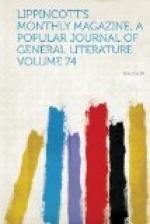I have considered sculpture less than painting in these remarks, partly because to the majority it is less interesting, and partly because it seems to me so much simpler in itself. The absence of color, the relief of form, the unity of idea, the limitation of each subject to a single figure, or at most two or three, perhaps too the repose and simplicity which characterize antique art, make the path less arduous. I never, even in the infinite vistas of the Vatican, felt the fatigue and perplexity which have beset me in the smallest picture-galleries.
If any reader has had patience with me until now, he or she may like to know the books which were of most use to me in my apprenticeship. There is no pleasanter instructress than Mrs. Jameson, although she is superficial and sentimental, a little lackadaisical indeed: her Early Italian Painters, Sacred and Legendary Art, and the supplementary volumes on the Legends of the Madonna and of the Monastic Orders, and on those relating to the life of our Lord, have all been republished in this country. There is a finer book of the same order, Lord Lindsay’s Christian Art, now out of print, but to be found in public libraries. M. Rio’s work, De l’Art Chretien (let the purchaser beware of two volumes of Epilogue, which are autobiography), is a full and admirable history of religious art: it is written from a purely Roman Catholic point of view, and his opinions are deeply imbued by prejudice. The reader will soon perceive this, however, and be upon his guard, remembering that, after all, the Roman Catholic view is the true one whence to contemplate art from the twelfth to the seventeenth century, but that art and theology are not one, nor even akin. M. Rio does not mention the Spanish school, perhaps with reason, as the Virgins of Murillo, the saints of Zurburan and Ribera, scarcely belong to the realm of religious art: this deficiency is supplied by Stirling’s Annals of the Artists of Spain. Kugler’s Handbuch der Kunstgeschichte (translated, I believe) is a capital and comprehensive work, including ancient as well as modern art; and the knowledge of the one is as necessary for the understanding of the other as an acquaintance with ancient history is for the comprehension of modern history. I cannot recommend Vasari’s Lives of the Italian Painters entertaining as it is, for so much of each page is taken up by notes of different editors and commentators denying flatly the assertions of the text that to read him for information seems waste of time. Messrs. Crowe and Cavalcaselle’s New History of Painting in Italy is the latest English authority. Mr. Charles Perkins’s Tuscan Sculptors, of which we have reason to be very proud, is already the accepted standard work everywhere. Kugler’s Handbook of the German and Dutch Schools, edited by Sir Edmund Head, has not been superseded, I think. It is with great hesitation that I name Mr. Ruskin in the




